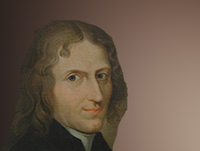With remarkable stubbornness, Giovanni Battista Guglielmini managed to overcome the financial straits of his humble origins and the scientific constraints imposed by the Church, becoming one of the greatest luminaries of Astronomy. His experiments definitively validated Copernicus' theories, which also probably germinated in and around the University of Bologna.
 Born in Bologna to a humble family, Giovanni Battista Guglielmini attended the city's seminary and only managed to enrol and graduate in Philosophy in 1787 through subsidies obtained from the University’s Assunteria. Having taken his vows as abbot, he was introduced by his master Sebastiano Canterzani, a mathematics professor, to Cardinal Ignazio Gaetano Boncompagni Ludovisi who, after his appointment as papal legate in Bologna, decided to take the young scholar with him to Rome (1788).
Born in Bologna to a humble family, Giovanni Battista Guglielmini attended the city's seminary and only managed to enrol and graduate in Philosophy in 1787 through subsidies obtained from the University’s Assunteria. Having taken his vows as abbot, he was introduced by his master Sebastiano Canterzani, a mathematics professor, to Cardinal Ignazio Gaetano Boncompagni Ludovisi who, after his appointment as papal legate in Bologna, decided to take the young scholar with him to Rome (1788).
It was during his Roman sojourn that Guglielmini began his many experiments to demonstrate the diurnal motion of the Earth by measuring the deviation from vertical of a free-falling body due to the Earth's motion. The time was ripe for empirical corroboration of Copernicus’ theories, which, despite still being placed on the Index of Prohibited Books, could now be studied and proven through new scientific works, due to the enlightened farsightedness of the Bolognese pontiff Benedict XIV (born Prospero Lorenzo Lambertini).
Thus, Riflessioni sopra un nuovo esperimento in prova del diurno moto della Terra (Reflections on a New Experiment to Test the Diurnal Motion of the Earth) was published in Rome in 1789, a treatise with which Guglielmini hoped to obtain permission to actually carry out the experiment at St. Peter's. Unfortunately for him, however, his protector Boncompagni Ludovisi was removed that very year from the secretariat of the Papal States and died the following year, thus leaving the Bolognese philosopher without any support in the capital.
For this reason, Guglielmini returned to Bologna in 1790, where he immediately joined the Accademia delle Scienze at the local Institute. With the encouragement of colleagues and friends, he chose the Asinelli tower as the best location for his 'weight test'. Being almost 100 metres tall, it had already been used for other scientific experiments, such as those on triangulation, carried out by the Jesuits Riccioli and Grimaldi in the 1640s.
The tower did indeed have a more than sufficient height to calculate the deviation of the sphere's fall, but due to its construction characteristics (still today, it features many holes, in which beams had been inserted during its construction and maintenance), the test could not be considered truly conclusive.
The Accademia then offered him the Specola Tower at Palazzo Poggi, home of the Institute, for the same test. Even today, the University Museum, which has its seat there, shows how Guglielmini’s simple test down a narrow spiral staircase served to successfully demonstrating the earth's motion. After a second attempt at the Torre degli Asinelli (1791), Guglielmini was finally able to publish his famous pamphlet De diurno Terrae motu in 1792.
With the arrival of Napoleon (1796), Guglielmini held numerous academic, university and political appointments.
In 1800 he was assigned the professorship of Sublime Mathematics, which was replaced shortly afterwards by that of Astronomy.
The University of Bologna was transformed into a state university in 1802 and was transferred the following year to Palazzo Poggi, after the Institute located there had been dissolved. This gave rise to the Academy of Fine Arts and the Institute for the Collection of Discoveries and the Improvement of Sciences and Arts, linked to the University. Guglielmini was to become a key player in this second body.
The now well-known astronomer was then involved in a complex water regulation and reclamation project for the entire Kingdom of Italy, especially the basin of the Reno in Bologna, which absorbed him almost completely from 1803 to 1807. During this period he gave up his professorship of Astronomy and once again took up that of Sublime Calculus.
After a short stay in Padua, he returned to Bologna, concentrated again on pure mathematics and was even elected rector for the academic year 1814-15, during a delicate period in which the difficult Austrian and Murattiano governments followed one another.
Finally, 1815 saw the publication of Elogio di Lionardo Pisano, a speech given by Guglielmini at the opening of the 1812 academic year, later greatly enriched with an in-depth history of medieval mathematics.
Guglielmini died in Bologna on 17 December 1817.
